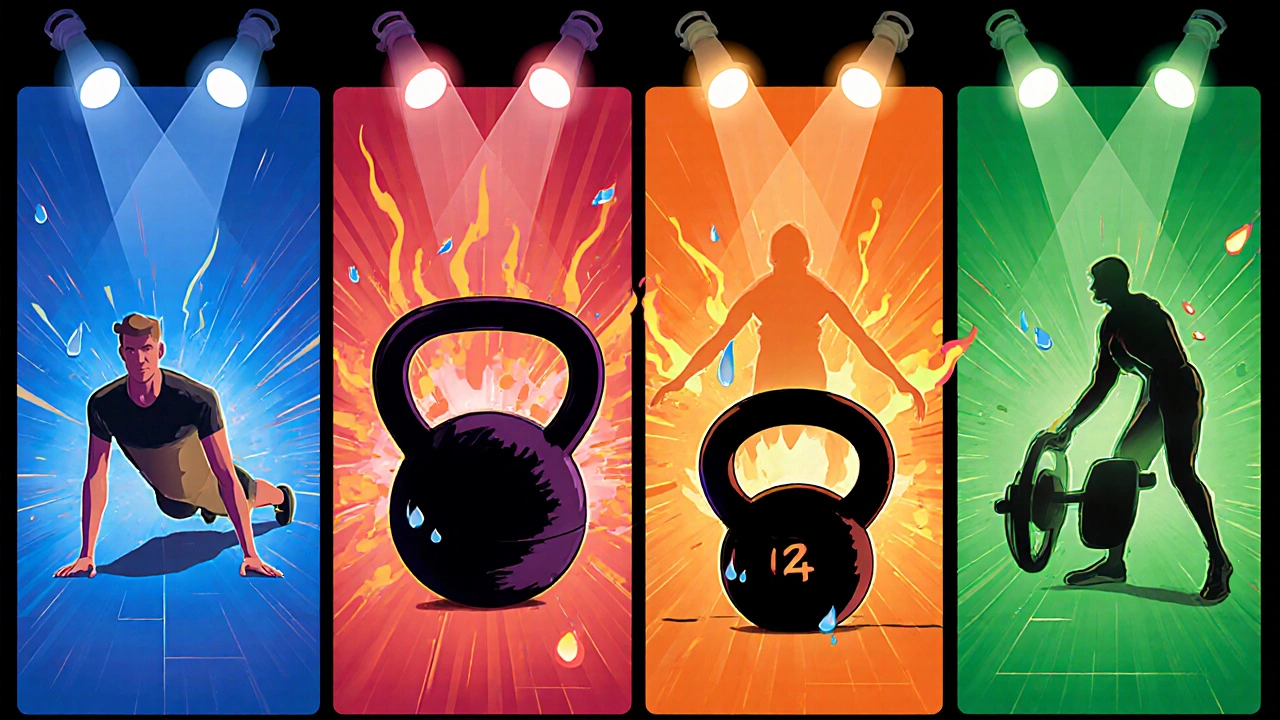5-4-3-2-1 Workout Calculator
Workout Calculator
How It Works
For each exercise, you perform:
- 5 reps
- 4 reps
- 3 reps
- 2 reps
- 1 rep
Total reps per exercise: 15
Total rest periods: 4 per exercise (between sets)
Workout Time Estimate
Estimated Total Time: 0 minutes 0 seconds
Work Time Total reps: @ 2s each =
Rest Time Rests: @ s each =
When you hear about the 5‑4‑3‑2‑1 workout is a fast‑paced interval routine that drops the rep count each set-5 reps, then 4, then 3, then 2, then 1-while keeping rest periods short. It’s a bite‑size version of high‑intensity interval training (HIIT) that promises a quick calorie burn and a solid strength stimulus without spending an hour in the gym. If you’re juggling a busy schedule or just want a fresh way to break plateaus, this pattern might be the answer.
How the 5‑4‑3‑2‑1 Structure Works
The core idea is simple: pick one or a few exercises, perform five reps, rest 15-30 seconds, then drop to four reps, rest again, and keep descending until you finish a single rep. The whole sequence usually lasts 5-10 minutes, depending on the rest length and number of exercises.
Because the rep count shrinks, you naturally speed up the pace, pushing your heart rate up while your muscles fatigue slower. This creates a metabolic storm-your body burns calories during the set and continues to do so after the session, a phenomenon known as excess post‑exercise oxygen consumption (EPOC).
Why It Fits Into HIIT
HIIT is defined by short bursts of work at near‑maximal effort followed by brief recovery. The HIIT methodology is flexible enough to include bodyweight circuits, kettlebell swings, sprint intervals, or even rowing. The 5‑4‑3‑2‑1 protocol satisfies the work‑to‑rest ratio that HIIT aficionados look for, typically ranging from 1:1 to 1:2. By stacking multiple sets back‑to‑back, you also tap into the "circuit training" principle, where you move from one exercise to the next with minimal downtime.
Choosing the Right Exercises
- Bodyweight movements: push‑ups, air squats, burpees, mountain climbers.
- Weighted lifts: dumbbell clean‑and‑press, kettlebell swings, barbell deadlift (light‑to‑moderate load).
- Cardio bursts: battle‑rope slams, box jumps, sled pushes.
Pick exercises that hit both upper and lower body for a balanced session. If you’re new, start with two moves-one push, one pull-so you can focus on form while the rep scheme does the rest.
Sample 5‑4‑3‑2‑1 Circuit
| Exercise | Reps (5‑4‑3‑2‑1) | Rest (seconds) |
|---|---|---|
| Push‑ups | 5 / 4 / 3 / 2 / 1 | 20 |
| Air Squats | 5 / 4 / 3 / 2 / 1 | 20 |
| Kettlebell Swings (12 kg) | 5 / 4 / 3 / 2 / 1 | 30 |
| Burpees | 5 / 4 / 3 / 2 / 1 | 30 |
Complete each column before moving to the next exercise. The total time for this circuit is roughly eight minutes, including rests.

Key Benefits You’ll Notice
- Time efficiency: finishes in under 10 minutes, perfect for busy days.
- Cardiovascular boost: heart rate spikes quickly, improving VO₂ max over weeks.
- Muscle endurance: the descending reps keep muscles under tension longer than a flat 5‑rep set.
- Calorie burn: high EPOC means you keep burning calories for up to an hour after finishing.
- Progressive overload: you can increase weight, add a round, or shorten rest intervals to keep challenging yourself.
Common Mistakes and How to Fix Them
- Using too much weight. The rapid tempo demands lighter loads. Aim for 40‑60 % of your 1RM for weighted moves.
- Skipping rest. Short rests are the secret sauce, but they shouldn’t be so brief that form collapses. Use a timer and stick to the programmed interval.
- Choosing only one body part. A full‑body circuit maximizes the HIIT effect. Pair push and pull or lower‑body moves.
- Neglecting warm‑up. Even a quick 5‑minute dynamic warm‑up (leg swings, arm circles, light jogging) prepares joints for the fast pace.
- Forgetting to track. Log the weight used, rest intervals, and how you felt. This data fuels progressive overload.
Scaling the Workout for Different Levels
Beginners can start with a single round, use bodyweight only, and extend rest to 45 seconds. Focus on mastering each movement before adding weight.
Intermediate lifters should aim for two rounds, incorporate moderate dumbbells (8‑12 kg), and keep rest at 20‑30 seconds.
Advanced athletes can crank it up to three rounds, use heavier kettlebells (16 kg+), and shave rests down to 10‑15 seconds. Adding a plyometric finisher (e.g., box jumps) after the main circuit adds an extra cardio punch.

Tracking Progress and Measuring Results
Because the workout is short, progress shows up in two main ways: speed and load. Record how long it takes to complete a round and the total weight moved. Over four weeks, aim for a 5‑10 % improvement in either metric.
Another useful metric is heart‑rate recovery. Use a wearable to capture your post‑exercise heart rate; a faster drop indicates improved cardiovascular fitness.
Putting It All Together: A Weekly Sample Plan
- Monday: 5‑4‑3‑2‑1 full‑body circuit (2 rounds)
- Wednesday: Traditional strength day (squat, bench, row)
- Friday: 5‑4‑3‑2‑1 upper‑body focus (push‑ups, kettlebell press, burpees)
- Saturday: Light cardio or mobility work
Mixing the 5‑4‑3‑2‑1 protocol with conventional strength sessions gives you both endurance and hypertrophy benefits without overtraining.
FAQ
Can I do the 5‑4‑3‑2‑1 workout at home?
Absolutely. All you need is a timer and a few pieces of equipment (dumbbells or kettlebells). Bodyweight moves work perfectly for a home setup.
How often should I repeat the 5‑4‑3‑2‑1 routine?
Two to three times a week is ideal. Space sessions by at least 48 hours to let your nervous system recover.
Is the 5‑4‑3‑2‑1 workout suitable for weight loss?
Yes. The high‑intensity bursts raise your metabolism and keep you in a calorie‑burning zone for hours after the session.
What’s the difference between this and a traditional 5‑rep set?
Traditional sets keep the rep count constant and usually include longer rests. The 5‑4‑3‑2‑1 format shortens rests and reduces reps each round, which spikes heart rate and creates a stronger metabolic effect.
Can I combine the 5‑4‑3‑2‑1 protocol with other HIIT methods?
Sure. Pair it with Tabata intervals or EMOM (every minute on the minute) to build a hybrid session that targets both strength and aerobic capacity.
Final Thoughts
If you’re after a quick, intense workout that hits strength, cardio, and calorie burn all at once, the 5‑4‑3‑2‑1 routine is worth a try. Its simplicity lets you slot it into any schedule, while the descending rep scheme keeps the body guessing and the heart racing. Start with bodyweight moves, track your progress, and gradually add weight or extra rounds. In a few weeks you’ll notice faster recovery, higher endurance, and a smoother path to your fitness goals.






